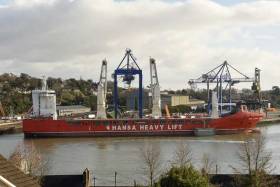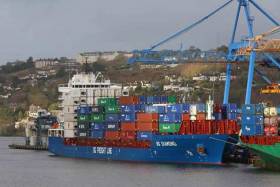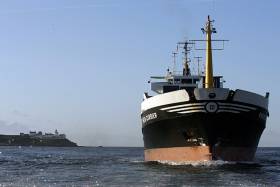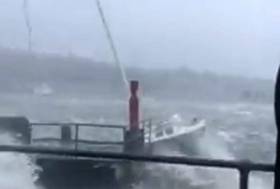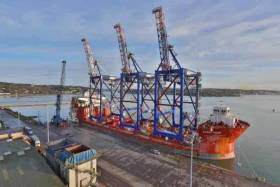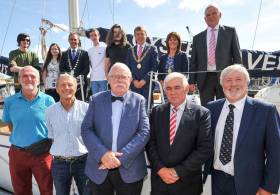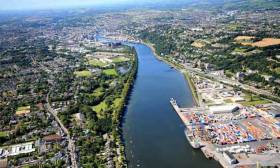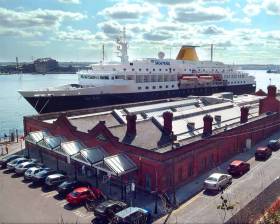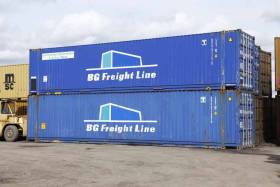Displaying items by tag: port of Cork
More Heavy Lift Operations At Cork Dockyard as 'HHL LAGOS' Arrives at Port of Cork
Since Friday (2nd February 2018) planned heavy lift operations at Cork Dockyard involve the loading of cargo onto the vessel ‘HHL Lagos’.
Last February, as Afloat.ie reported at the time here, the same Cork Harbour dockyard was the site selected for loading massive Liebherr cranes onto an equally massive ship bound for Puerto Rico.
Current operations with HHL Lagos will occur at multiple times, for periods of up to five hours, according to the Harbourmaster. These operations are planned to be completed within 1 (one) week.
During the lifting operations, commercial vessel traffic may be restricted from navigating in the vicinity of Cork Dockyard to facilitate safe operations. Vessels navigating in the area must contact Port of Cork Operations on VHF Channel 12 for details of any lifting operations, and associated navigation restrictions.
Once the cargo has been loaded onto the HHL Lago, this cargo shall overhang into the navigation channel.
Vessel Masters & operators are requested to pass HHL Lagos at a minimum safe speed and producing no visible wash for the duration of the HHL Lagos’s stay at Cork Dockyard.
Furthermore, vessels are requested to keep a sharp lookout for any potential overhangs and obstructions from the HHL Lagos, and to closely monitor VHF Channel 12 at all times for information updates.
MV 'BG Diamond’ Makes Her Maiden Call To Port Of Cork
BG Freight Line’s latest new build MV ‘BG Diamond’ arrived in the Port of Cork today on her maiden call to Tivoli Container Terminal from Rotterdam. The brand new containership developed by BG Freight Line, in conjunction with designers CIMC ORIC and Arkon Shipping and is one of four brand new ships developed by BG Freight Line capable of loading 45ft short-sea containers. The new BG Freight vessel is the max size vessel for Tivoli Container Terminal.
Brendan Keating CEO Port of Cork said: ‘BG Freight Line is a longstanding customer to the Port of Cork and this new build vessel shows a further commitment for our future relationship. Port of Cork is committed to providing modern infrastructure which will remove the current limitations at up-river berths. The new facilities planned for Ringaskiddy Port Redevelopment, Cork Container Terminal (CCT) will further improve the Ports capability to handle the growing Lo-Lo sector. CCT when completed will be the most modern terminal in Ireland and will serve the regions shipping needs for many years to come.’
MV ‘BG Diamond’ is fitted with state-of-the-art features such as a modern wet scrubber system for exhaust cleaning which complies with Emission Control Area (ECA) requirements.
Koert Luitwieler CEO BG Freight Line said: ‘We are extremely proud that our first newbuilding, the mv ‘BG Diamond’ is now deployed on our dedicated route between Rotterdam and Cork. This is an important mark in the long history of BG Freight Line and will enable us to trade with highly fuel efficient and environmental friendly tonnage for the next decades.’
Port Of Cork Company & Bantry Bay Port Trade Traffic Up 8.6% In 2017
Combined total traffic through the Port of Cork and Bantry Bay Port Company reached 10.3 million tonnes in 2017, a very good increase of 8.6% compared to 2016. Total imports increased by 6.4% while exports increased by 12.3%. The Port of Cork total container volumes through both Tivoli and Ringaskiddy Container Terminals grew by 3.7% compared to 2016 figures, with a total of 217,763 TEU’s handled in 2017.
Oil traffic, predominantly handled through Whitegate Oil Refinery now owned by Canadian company Irving Oil, saw an increase of 2%. Trade in dry bulk cargos such as animal feed, fertilisers and cereals saw increases throughout the year.
In 2017 the Port of Cork handled 68 cruise liners bringing over 140,000 passengers and crew to the region, while in Bantry Bay five cruise liners visited the harbour, with MV Prinsendam making her maiden call to Bantry, the first liner to do so in 30 years.
Brendan Keating, Chief Executive said: ‘We are encouraged by the increase in trade traffic through the Port of Cork and Bantry Bay Port in 2017. An 8.6% increase in total trade traffic shows the positivity in the markets which were showing a marginal decrease in 2016. We are particularly encouraged by the growth in container traffic through both Tivoli and Ringaskiddy which increased by 3.7%. This increase is a clear indication that consumer markets are beginning to open up with both imports and exports on the rise through Cork.’
He continued: ‘In 2017 the Port of Cork saw over 34,000 trade vehicles imported through Cork. The trade car market is very important for Cork, however unfortunately we saw some decreases in the volume of cars imported. With regards to tourism, the Port of Cork had a very positive year with 68 cruise liners calling bringing over 142,000 passengers and crew to visit the Munster region. Furthermore, in 2017, for the second year running, Cobh was named the second Best Cruise Destination in the British Isles & Western Europe in the Cruise Critic Cruisers’ Choice Destination Awards, a further endorsement of our cruise business.’
Commenting on Bantry Bay Port Company, Brendan Keating said: ‘In August 2017, we successfully completed and opened Bantry Harbour Marina, part of the inner harbour development. This new sheltered harbour facility will be of great benefit to both commercial and leisure users bringing increased activity to Bantry Harbour and Town. The cruise business has doubled with ten cruise liners expected to call in 2018.’
Following the recent announcement by Brittany Ferries on their new twice weekly Ro-Pax route from Cork to Santander due to commence in April 2018, Mr. Keating said: ‘In 2018 Brittany Ferries celebrate 40 years operating in Ireland and we are very pleased with the announcement of this new route both in terms of tourism and trade. The current weekly route from Cork to Roscoff continues to strengthening with Brittany Ferries carrying over 80,000 passengers in 2017 and we look forward with great optimism to additional passengers availing of Brittany Ferries new service and the second call to Roscoff per week.’
In 2017 the Port of Cork Company signed a Memorandum of Understanding (MOU) with NextDecade Corporation (NASDAQ: NEXT), a U.S.-based Liquefied Natural Gas (LNG) to explore a joint development opportunity for a new Floating Storage Regasification Unit (FSRU) and associated LNG import terminal infrastructure in Cork Harbour
Mr. Keating said: ‘As an entry point into the Irish energy market, the Port of Cork is an attractive location for an FSRU-based LNG import terminal. Surrounded by existing marine infrastructure and industrial facilities, the proposed site is less than 2 km from Gas Networks Ireland Grid and would benefit from relatively benign and attractive conditions.’
He continued: ‘Discussions are ongoing with the Port of Cork and NEXTDecade, as well as other key industry players, who are supportive of this project and we are excited by the opportunities that this project could present.’
In 2015 An Bord Pleanala granted a 10-year planning permission to Port of Cork for the redevelopment of the existing port facilities at Ringaskiddy and in 2017 An Bord Pleanala granted permission for alterations to the terms of the Ringaskiddy Port Development. The permission will enable the Port to deliver more efficient container handling facilities, replacing the existing container terminal at Tivoli, and securing Cork Container Terminal as an international gateway for trade well into the future.
Ringaskiddy Port Redevelopment will future proof Cork trade and Port of Cork look forward to the project progressing in 2018.
Storm Ophelia Video: Cork Harbour Yacht Breaks Moorings in Monkstown Bay
A video of a yacht that broke free of its mooring in the teeth of Storm Ophelia in Cork Harbour, has recorded over 50k views on social media.
The Ensign Bar in Monkstown Co. Cork posted the vid on Facebook in the teeth of the Hurricane when Force 12 winds tore across the harbour, closing the Port of Cork.
With halyards and furling headsail flying, the seemingly doomed yacht narrowly avoids collision with Monkstown's quay wall then disappears downwind in the spume and waves lashing up on Cork harbour walls.
Three died in separate incidents as over 200,000 left without power when the hurricane struck Ireland today.
Storm Ophelia: Port of Cork Shipping Movements Suspended
All Port of Cork shipping movements have been suspended in the harbour since 0600 this morning.
Cargo operations are suspended until further notice, all cranes and cargo handling equipment have been secured until the storm passes.
All persons are advised to stay away from the quays and exposed areas within the harbour.
Marine leisure craft are advised to stay off the river until the storm has abated.
Cork Sail Training Bursary Awards Celebrate Tall Ship Voyage Achievements
A presentation ceremony took place in the Port of Cork to celebrate the achievement of 26 young people from all backgrounds and a range of abilities across Cork City and County who completed voyages aboard the Cork-Based Vessel Spirit of Oysterhaven and the Tall Ship Pelican of London during the 2017 season. These voyages were made possible by a group of generous sponsors including Port of Cork, Cork City Council, Cork County Council, Dell, Ardmore Shipping, Enterprise System Partners, The Institute of Master Mariners and the National Maritime College of Ireland.
Four trainees from the City and County crewed the Pelican from Dublin arriving in Belfast after 12 days exploring around the Irish sea. The Pelican was due to call to Cork during this voyage but unfortunately was forced to turn back due to adverse weather. Another two Cork trainees sailed from Belfast to Liverpool and on to Dublin over 10 days. These trainees formed part of groups with up-to 28 trainees and mentors on each voyage which were part funded using EU “Erasmus +” funding and involved active educational programmes of youth development as part of “Youth Exchange” projects.
In addition 20 Cork based young people took part on two six day voyages on the gorgeous local vessel Spirit of Oysterhaven. These lucky trainees enjoyed the beautiful coastline scenery while sailing between Glandore and Cork.
The Cork Sail Training Bursary Scheme was established in 2014 to provide access to Sail Training voyages on tall ships and large sailing vessels for young people from the region. Now in its fourth year the scheme is one of the largest and most active on the Island of Ireland and runs in parallel with similar schemes now in operation under Sail Training Ireland in Belfast, Drogheda, Dublin, Waterford, and Galway. The participants are nominated through a network of youth and community groups in Cork and places are available to young people from all backgrounds and with all abilities. The scheme has supported approximately 80 trainees since 2014 and looks likely to grow from strength to strength over the coming years.
Also present on the day were trainees straight off the “Spirit of Oysterhaven” having finished their recent voyage today (day of event 1st of September), following 6 days at sea beginning in Glandore County Cork. The vessel was alongside in Port of Cork during the event and opened to visitors afterwards.
“Our young people returned to us not just with new experiences but new skills, new friendships and new directions for the future.” Cork Life Centre.
Speaking at the presentation ceremony, Brendan Keating Chief Executive said: ‘The Port has been involved with Sail Training Ireland for a number of years now and has supported many voyages for young adults. We feel this is a very worthwhile initiative for the Port of Cork which teaches seamanship, teamwork, personal development and importantly gives them an awareness of life at sea. We would like to commend all 26 of the young trainees today and wish them the very best for their futures.’
MC for the event was former RTE Radio “SeaScapes” Presenter Marcus Connaughton (Goodwill Ambassador for Sail Training Ireland) and the certificates were presented to trainees by Lord Mayor of Cork City Tony Fitzgerald, County Mayor Declan Hurley and Commodore Hugh Tully Flag Officer Commanding Naval Service (F.O.C.N.S.). The Naval Service is a strong supporter of Sail Training for young people as a stepping stone into maritime careers.
Cork – A River Port to a Sea Port
In an exclusive interview for my weekly This Island Nation podcast, the Chairman of Cork Port says that it is moving “from a city port to a sea port.”
Listen to John Mullins as he outlines why the port company “must leave a legacy behind to Cork City as it moves its operations downriver to Ringaskiddy and must create new relationships with all of the harbour communities.”
He spoke to me at the announcement of the Cork Harbour Festival, which will run from June 3 to June 11.
Listen to the podcast below where he also speaks about plans for Marino Point and reveals what is proposed for the development of the iconic, historic harbour offices and buildings on Custom House Quay in Cork City centre and the marina attached to it.
‘Saga Pearl 2’ Commences Port of Cork Cruise Season 2017
Saga Cruises’ MV Saga Pearl 2 will start the Port of Cork’s cruise liner season on 20th March, the first of 65 calls expected to visit Cork this season. Seven new liners will call this season on their maiden call, while Princess Cruises’ MV Caribbean Princess carrying 3,500 passengers will make fourteen visits this season.
With 65 calls in 2017, the Port of Cork anticipates a very busy season ahead for all involved, and an increased economic benefit for the region. Approximately 160,000 passengers and crew are expected to visit the city and county between March and November.
Commercial Manager at the Port of Cork, Captain Michael McCarthy said: ‘The 2017 Cork cruise season is booming which is great for the port and the region. The numbers of calls are up compared to 2016 and we feel very positive about this increase in business. It’s also very encouraging to see cruise lines bringing their newest vessels to Cork on maiden calls and choosing Cobh as part of their cruising route.’
He continued: ‘It is our ambition as a port company to attract larger cruise ships and increase our cruise calls to 75 per year. Already in 2018 the bookings are indicating we will achieve this goal, if not exceed it.’
In 2016 Cruise Critic, the world's leading cruise review site and online cruise community, announced the winners of the inaugural Cruise Critic Cruisers’ Choice Destination Awards with Cork’s Cobh ranked second favourite cruise destination in the British Isles and Western Europe. These awards recognised the high level of effort that goes into ensuring every cruise passenger visiting Cobh has a memorable visit to the region.
As well as Cork the Port of Cork also operates Bantry Bay Port Company which will see eight cruise liners calling to the West Cork area this summer. Bantry Harbour and Glengarriff can accommodate the smaller boutique cruise liners whose passengers tend to look for active expedition cruises.
BG Freight Line Announce New Container Service from Port of Cork
Leeside Shipping, agents for BG Freight Line in Cork have announced a new container service between the ports of Cork and Liverpool. This new service is due to commence at the end of March 2017.
This is the first time these ports have been connected directly, and the new route will offer greater opportunities for customers in the South of Ireland to make connections with the deep-sea services now calling at the Port of Liverpool, particularly from Canada, the east coast of the US and the Mediterranean.
The new service will also provide a quay-to-quay route for tank operators, and door to door opportunities into the North of England, Midlands and Scotland - regions previously only accessible via Dublin.
The weekly schedule will be:
Saturday Liverpool
Monday Cork
Wednesday Liverpool
At the end of the each week, the vessel will continue to offer services between Belfast, Greenock and Liverpool.
BG Freight Line is one of the companies within the Peel Ports Group, and currently operates 23 containerised vessels, offering a variety of services at following Ports:
Cork, Dublin
Belfast
Felixstowe, Teesport, South Shields, Immingham, Liverpool
Grangemouth, Greenock
Antwerp
Rotterdam
Montoir, Brest, Dunkerque
Their frequency of sailings is one of the best in the trade, with each Port having at least two calls per week.
Commenting on this new container service, Port of Cork Harbour Master Captain Paul O’Regan said: ‘We welcome this new freight service with BG Freight Line as it opens up further frequent freight movements from Cork, with the added benefit of deep sea connections via Liverpool to the US and the Mediterranean.’
In 2016, BG Freight Line was named the Ship Operator of the Year at the Marine Industry Awards. ‘As an island economy, Ireland needs shipping services to access markets around the world. The reliability, efficiency and competitiveness of these services influence national competitiveness, international trade and the job creation potential of the Irish Economy. Put simply, excellent shipping services help the Irish economy to grow. This reward recognises excellent in this mode of transport’.
In 2018, the company will take delivery of 4 new build ‘green’ vessels. The sister ships are currently under construction at Zhoushan Changhong International Shipyard, and have been developed by BG Freight Line, in conjunction with designers CIMC ORIC and Arkon Shipping. The vessels are being built to DNV GL specification and fitted with state-of-the-art features in order to comply with Emission Control Area (ECA) requirements - a clear commitment to achieving the highest possible environmental standards.
Opening Up Bantry Bay – A Maritime Hub In the South West
Bantry Bay is one of this island’s greatest maritime resources and is about to be opened up with a new marina very close to the centre of the town. Twenty-two miles long from its entrance and with 22 slipways and launching areas, plus a couple of islands, this can be a cruising mecca.
The Port of Cork Company which took over Bantry Harbour from the previous local harbour authority, has spent €9.5m. on the development of facilities there, turning the old pier area into a more extensive commercial facility, improving depth of access and providing in the inner harbour, a new marina. The development will operate under the aegis of the Bantry Bay Port Company.
All of this promises a new future for the harbour and Bantry as a maritime hub, not only for the leisure sailor, but for angling, fishing, other maritime activities and attracting more cruise ship visits by the improve facilities. The marina will provide 30/40 berths dependent upon size of vessel, dredged to a depth of 4 metres.
On this week’s THIS ISLAND NATION PODCAST, Cork and Bantry Harbour Master, Captain Paul O’Regan, outlines the development to me. I started by observing that nine-and-a-half million Euros was a big financial commitment to Bantry.


























